History of the House at 14 Hayden Hill Road
The Thankful Arnold House Museum is a historic house museum dating from the late 18th century located in the picturesque village of Haddam, Connecticut along the Connecticut River. Distinguished by its gambrel roof with unusual bell-shaped profile, the house was built in three distinct stages between 1794 and 1810. Today the house provides a glimpse of the life of the Widow Thankful Arnold in the late 1820s shortly after her husband's untimely death. The property remained in the Arnold Family until the 1960s when it became the home of the Haddam Historical Society.
Linus Parmalee erected the first phase of the building, which consisted of the eastern two bays and was one room deep, in 1795. When Haddam became a half-shire town in 1785 the resulting activity and business caused a brief building spurt. Parmalee already owned other properties in town when he purchased the small empty lot in 1794. He probably intended this new building to be used for investment purposes. It consisted of three rooms, a "shop" on the basement level, a parlor/kitchen on the second floor and a sleeping or storage loft in the attic. Needing more money, Parmalee mortgaged the "small" house shortly after it was built and lost it in 1797 to John and Andrew Cook in a foreclosure petition. The Cooks turned around and sold "the small dwelling with store" to Joseph Arnold.
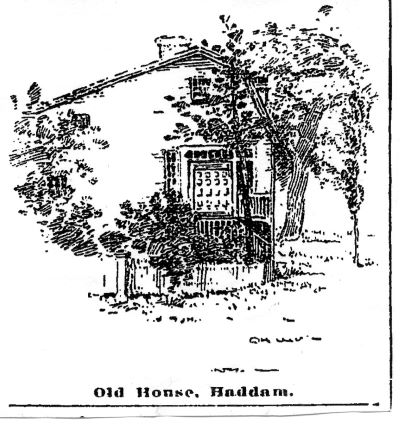 Joseph brought his young wife Thankful and infant daughter Nancy to the newly purchased home in June of 1798. Joseph and Thankful were among the first generation of United States citizens. Both were born at the beginning of the War for Independence, Joseph in 1774 and Thankful in 1776, and their earliest memories must have included absent soldier fathers and wartime shortages.
Joseph brought his young wife Thankful and infant daughter Nancy to the newly purchased home in June of 1798. Joseph and Thankful were among the first generation of United States citizens. Both were born at the beginning of the War for Independence, Joseph in 1774 and Thankful in 1776, and their earliest memories must have included absent soldier fathers and wartime shortages.
Joseph was the son of Samuel and Elizabeth (Smith) Arnold and direct descendant of Joseph Arnold, one of the original proprietors of Haddam and his namesake. In 1797, Joseph at the age of 23 married Thankful Clark, age 21 of Chester, Connecticut. She was the daughter of Joseph and Sarah (Dudley) Clark and could trace her lineage back to John Alden and Priscilla Mullins of Plymouth Colony.
Joseph and Thankful Arnold met many of the requirements to be considered members of the local elite. Both came from families of original proprietors. They were members of the Congregational Church. If Joseph had been a few years older and better established, or if his father had more money to endow his son with a larger competency when he first married, perhaps he and Thankful would have purchased a larger dwelling. As it was, they did what many young couples still do today; they purchased a "starter" home in a good location and enlarged it as they became more financially secure.
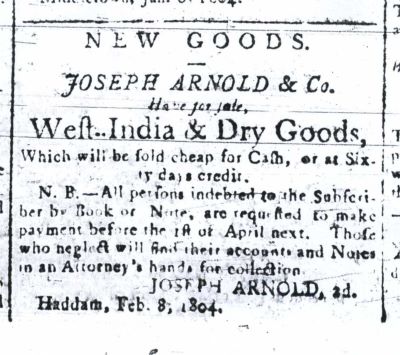 The street-level portion of the building was used by Joseph as a shop or office. Letters found in the home were addressed to JOS. ARNOLD, MERCHANT and some architectural details in the basement, such as the built-in drawers, indicate he operated a store here. Over the years Joseph Arnold expanded his commercial interests and became involved in turnpike building, commercial fishing sites, quarrying, money lending and real estate. It is also believed he was involved in commercial ventures in Old Saybrook and Old Lyme and was appointed a Justice of the Peace. By the 1820s Joseph Arnold was financially involved in virtually every profitable enterprise in Haddam and was recognizably one of Haddam's social elite.
The street-level portion of the building was used by Joseph as a shop or office. Letters found in the home were addressed to JOS. ARNOLD, MERCHANT and some architectural details in the basement, such as the built-in drawers, indicate he operated a store here. Over the years Joseph Arnold expanded his commercial interests and became involved in turnpike building, commercial fishing sites, quarrying, money lending and real estate. It is also believed he was involved in commercial ventures in Old Saybrook and Old Lyme and was appointed a Justice of the Peace. By the 1820s Joseph Arnold was financially involved in virtually every profitable enterprise in Haddam and was recognizably one of Haddam's social elite.
Family functions took place on the middle and attic floors. Architectural evidence indicates that when the Arnolds first purchased the house it was only one room deep and two-bays wide, measuring about 15 x 14 feet. The room on the first floor would have been used for cooking, sleeping, and family living, as well as receiving guests. The little house had a gambrel roof, which permitted a more efficient use of the attic area without significantly increasing the construction costs of the building. The large chimney was an end chimney. In addition to daily tasks, Thankful would have to do seasonal duties including making candles and soap. The attic floor contained a finished room with small fireplace which provided additional sleeping and storage space. Since no interior stair well was discovered within the first phase of the house during the restoration process, the attic may have been reached by using a ladder. The basement, which usually would have been a storage cellar or cooking space, consisted of a finished room accessible only through an exterior door onto the street. This would have been Joseph's "shop" or business office.
Just three months after moving into their new home the Arnolds lost their 13-month old daughter Nancy. Without completely alleviating their grief, the acuteness of the young parents' loss may have been partially eased by the birth two months later of their second child and first son, Jonathan Arnold. Two years later in 1800, the Arnolds welcomed their third child, a daughter whom they named Nancy in honor of their first daughter. The Arnold's had a total of 12 children altogether. Following Nancy II was Joseph Jr. born in 1802, George born in 1803, Ann born in 1805, Samuel II born in 1806, William born in 1808, Hannah born in 1810, Sarah Elizabeth born in 1813, Isaac born in 1815 and Charles born in 1817. Ann, like Nancy I, died as an infant, but all the remaining children survived early childhood.
As the family grew, there was a need to expand the living quarters of the house and as Joseph's business prospered it was necessary to enlarge his "commercial space" on the basement level. In 1800 only two years after they moved in, the Arnolds expanded the house by adding two bays to the west. Since the cellar and attic were also enlarged the house now had two rooms on each floor.
A significant aspect of this building phase was the chimney alterations. What had started out as an end chimney became a center chimney and two new fireplaces were added to the house; one in the new kitchen and one on the cellar level.
Thankful moved her kitchen from the front room to the new space. She now had a formal parlor which was more in keeping with the family's social status in town. The room was reserved for important guests and this is where they would be received and served refreshments. The room also displays the finest furniture including an 18th century writing desk from the Burr Family and a Brainerd Family chest-over-chest.
By 1809 the Arnolds had six children and one more on the way and they were ready to expand again. In 1810 remodeling began by moving an existing mid-eighteenth century building to abut the west side of the house. The original use and location of this small building is unknown. It may have been an outbuilding standing on the property which was no longer needed for its original purpose, or it may have been a small dwelling from elsewhere in town. Whatever its source, it was not unusual to move existing structures to combine them with others. A new foundation was dug for the new addition, and the cellar of the Arnold House once again was increased in size. Another door opening from the cellar on to the street was added, and its dimensions suggest the space within might have been used for storing large barrels or casks. This addition provided another room to the main living level that may have been used as a bedroom and storage space above that.
A new kitchen extending along the full length of the south side or back of the house was also added at this time. As with the 1800 addition, the new kitchen meant the chimney had to be remodeled. The entrance and flue to the bake oven from the earlier kitchen was turned ninety degrees into the new room, and a large cooking hearth was added to the chimney mass. A shed roof was constructed to cover this addition, creating what the Arnold's would have called a lean-to, and what today is known as a salt box house. The long slope of the new roofline also provided additional space in the attic.
When the Arnolds finished the 1810 renovations the home was completed. Joseph used the basement level for his shop, office and warehouse. Thankful had a formal parlor, back parlor, large kitchen, buttery and possible bedroom on the main level and two bedrooms and storage space in the attic. It is believed that the Arnold Family may have earned additional money by taking in boarders, especially when the local court was in session.
In early January of 1823, Joseph Arnold died three days before his thirteen-year-old daughter Hannah. Both deaths caught the family unprepared. Joseph not only died intestate (without a will) but left many unpaid bills. In an age before ready cash or monthly credit card statements, it was not unusual for credit to be extended for long periods of time. When someone died leaving no will and owing money, the best way for creditors to collect their money was to submit an immediate bill to the estate of the deceased. Frequently the only way to settle the outstanding bills was to liquidate the estate.
This was Thankful's fate at the age of 47. Dower rights protected a widow from losing everything, but without a will, the law only guaranteed her the use or profit from one-third of her husband's real estate for her lifetime. Because there was no will the Probate Court appointed appraisers to come in to her home and valuate and list all of the deceased's property. The appraisers stayed three days and itemized everything Joseph owned. His estate came close to $4500 in assets, a significant amount for that time. However Joseph's debts exceeded $3600. Upon completing the inventory, a public sale or vendue was held and the proceeds went to those who submitted claims. Selling most of his property was the only way to raise sufficient funds to cover his debts.
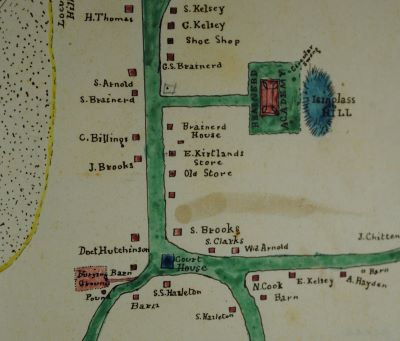 Thankful was allowed one-third of the house for the rest of her life, but the rest of the house was put up for sale. Many widows from this time period found themselves sharing their homes with new owners (often relatives) and had to live with restrictions (meant to protect the widow) placed on them from the court. The judge might determine which rooms, or even entryways, she could use, when she could use the fireplace and where on the property she might have a garden. The new owners might be required to provide for the widow in certain ways such as performing tasks or providing food. Thankful was very fortunate in this regard. Her brother-in-law, Samuel Arnold from Massachusetts, purchased the house and allowed the Widow Arnold to remain in the house with her young children. He later sold the house to Thankful's son, Samuel Arnold 2nd, who maintained the property for his mother and sisters Nancy and Sarah.
Thankful was allowed one-third of the house for the rest of her life, but the rest of the house was put up for sale. Many widows from this time period found themselves sharing their homes with new owners (often relatives) and had to live with restrictions (meant to protect the widow) placed on them from the court. The judge might determine which rooms, or even entryways, she could use, when she could use the fireplace and where on the property she might have a garden. The new owners might be required to provide for the widow in certain ways such as performing tasks or providing food. Thankful was very fortunate in this regard. Her brother-in-law, Samuel Arnold from Massachusetts, purchased the house and allowed the Widow Arnold to remain in the house with her young children. He later sold the house to Thankful's son, Samuel Arnold 2nd, who maintained the property for his mother and sisters Nancy and Sarah.
Many things changed for Thankful with Joseph's death; she lost much of her financial security and social status as well as his companionship. Other things, however, would have remained the same. There were still meals to prepare, children to care for, gardens to keep, clothes to be made and mended. In order to earn some income, it is believed Thankful continued to rent out beds to paying guests including lawyers, plaintiffs and judges who were in town to attend court in the courthouse located directly across the street. Whenever the Haddam county court was in session traffic and business increased in town, particularly for someone living as close to the courthouse as Thankful. She may have also rented out bedrooms to students of Brainerd Academy, which was located just to the south.
Family papers and the traditions of calling the house the Widow Arnold House indicate that Thankful continued to reside here until her death. Her son Samuel's account book refers to work done on his mother's house and property and an insurance policy he purchased in 1842 describes the house as the residence of Thankful and her daughters. All of the Arnold sons left home to start their own households, but the two living daughters, Nancy II and Sarah Elizabeth, never married and continued to live with their mother.
Thankful died in August of 1849 at the age of 73 and was buried near her husband in the Thirty Mile Island Plantation Burial Yard. Her dower rights were shared among her surviving children, but only her two daughters continued to live in the house. Two months after her death, Thankful's 36-year-old daughter Sarah Elizabeth died and oldest daughter Nancy II became the head of the household.
Miss Nancy's House
Nancy's earliest years in the house were filled with the smells of sawdust and fresh plaster. Thankful and Joseph were in the midst of their first architectural expansion when she was born, and had completed their last before her 10th birthday. As the oldest daughter, Nancy became responsible at an early age for tending younger siblings, and she would have quickly learned to help her mother with many of the domestic chores necessary to managing a household of any size.
There was always sewing to be done, and the fingers of even very young girls were skilled enough to master the yards of hemming required for bed sheets, toweling, chemises, shirts and of course baby diapers. By the time she was an adult, Nancy was talented enough to sew pantaloons for her brother Isaac, an accomplishment which required tailoring skills most sewers lacked. Nancy's childhood and adulthood were spent doing the many household duties expected of 19th-century women. This included taking care of the cow, poultry and swine, spinning, washing, ironing, gardening, baking, cleaning, and sweeping—not to mention seasonal duties including candle making, soap making, and animal slaughtering.
When family or friends fell ill, Nancy would have assisted her mother in caring for them, and assumed an ever-increasing amount of responsibility with the birth of each new sibling. Because of her gender and birth order, Nancy soon became and always remained an integral part of the management of this house.
The reason for Nancy's state of "blessed singleness" is of course unknown, and without personal papers we can only guess why neither she nor her younger sister Sarah married. Deaths and serious injuries caused by the Revolutionary War reduced the number of marriageable men, and the out migration which began in the late 1700s further depleted the male population. Another more interesting reason for the increasing number of single women, however, is the deliberate choice of many young women to not marry. Following the Revolution, many social commentators wrote of the importance of American female citizens. Ministers and essayists urged women not only to be virtuous and hold high ideals for their own sakes, but for the sake of all the men in their lives, and the benefit of their new nation. As women were requested to assume more personal responsibility for society they began to exert more choices in their personal lives. Women responded to this social pressure in a variety of ways, many not even consciously recognizing its influence. Some women did not consider marriage essential to happiness.
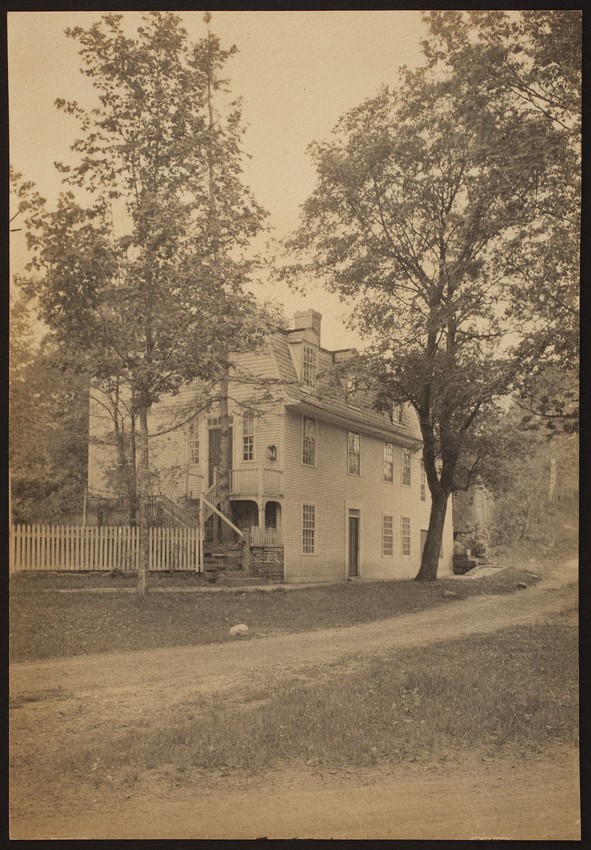 Little is known about Nancy's life. She spent her 49 years first assisting her mother then managing her own household. As the oldest sister she had ample opportunity to tend to small children, something she must have enjoyed, for as an adult she welcomed two young nieces into her home to live with her. Nancy may have continued to take in boarders and was assisted financially by her brothers, particularly Samuel 2nd, which allowed her to enjoy a standard of living that enabled her to manage her own household and fully participate in Haddam's society.
Little is known about Nancy's life. She spent her 49 years first assisting her mother then managing her own household. As the oldest sister she had ample opportunity to tend to small children, something she must have enjoyed, for as an adult she welcomed two young nieces into her home to live with her. Nancy may have continued to take in boarders and was assisted financially by her brothers, particularly Samuel 2nd, which allowed her to enjoy a standard of living that enabled her to manage her own household and fully participate in Haddam's society.
When her brother Samuel died in 1865 the ownership of the house was dispersed among family members and brother Isaac eventually took title to the house. In 1869 Nancy remodeled the house by raising the long sloping roof over the kitchen to create another bedchamber in the attic. This may have provided additional rooms for boarders. It is recorded that she had long-term tenants such as Chauncy and Addie Smith, a young sailor and his wife and their four-year-old daughter who were listed in the 1870 census as residents of Miss Nancy's household.
Church records indicate that Nancy's parents and brothers Jonathan and Isaac remained Congregationalist throughout their lives, but Nancy became a Methodist. Nancy died in January 1884 leaving no will and no inventory and it is not known where she is buried. Although not much is known of Nancy's life, she must have been a familiar figure in 19th-century Haddam, having called this house "home" for over 80 years, longer than anyone before or after her.
“A Lady of Ability”, Sabra Anna Arnold Ingersoll
The next resident of the house was Sabra Anna Arnold Ingersoll, Thankful's granddaughter, Nancy's niece and the only daughter of Isaac Arnold. Isaac was one of Haddam's leading citizens and was involved in numerous enterprises. His chief business was owning and operating Arnold's Quarry with his brother Samuel, although he also owned bank stock, loaned money and had investments in real estate, transportation and commerce. The quarry was an extremely successful venture and the granite quarried was shipped to many locations including the newly expanding or improving cities like New Orleans and Philadelphia.
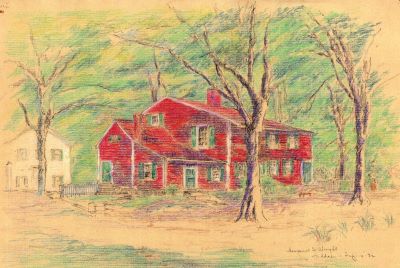 Sabra had a financially and socially secure childhood, due to her father's prosperity and prominence. Despite the fact that her mother, Mary Ann Thomas, died when Sabra was only three, the love and support provided by her family including aunt Maria must have been stabilizing influences in her life, particularly after Maria became her stepmother. Until she reached her early teens, Sabra attended the First School District in Haddam, then continued her education in private school, including Miss Payne's Academy in Middletown, Connecticut. In November of 1872 Sabra married John Ingersoll, a business associate of her fathers. They had two children, Harriet and Charles Ingersoll.
Sabra had a financially and socially secure childhood, due to her father's prosperity and prominence. Despite the fact that her mother, Mary Ann Thomas, died when Sabra was only three, the love and support provided by her family including aunt Maria must have been stabilizing influences in her life, particularly after Maria became her stepmother. Until she reached her early teens, Sabra attended the First School District in Haddam, then continued her education in private school, including Miss Payne's Academy in Middletown, Connecticut. In November of 1872 Sabra married John Ingersoll, a business associate of her fathers. They had two children, Harriet and Charles Ingersoll.
In 1885, just a year after Nancy's death, Sabra found her self suddenly widowed when her husband died from pneumonia. Sabra was grief-stricken. The couple had been married only 13 years when she became a 40-year-old widow with two children under the age of 10. It was also at this time that her father, Isaac, was experiencing serious financial difficulties and had been declared insolvent by the State of Connecticut. Both Isaac and the Ingersolls had lost their homes through foreclosure by 1885 and it is believed they took up residence in Nancy's empty home. Prior to his financial troubles, Isaac had sold his parents'/sister's home to his 13-year-old grandson, Henry I. Arnold in 1879. When Henry became of age in 1887 he gave power of attorney to his aunt Sabra. Eventually Sabra took title to the house in 1902 and she continued to live in her "pleasant home" until her death in 1920.
The Old Red House
Sabra's son Charlie called the Thankful Arnold House his home for most of his life. He was seven years old when his father died and the family took up residence here. He attended the local district school and was close to his grandfather Isaac who took him hunting and shared his love of horses and dogs. In 1902 Charlie married Cornelia Post of Westbrook and, after traveling for some time, settled in Haddam with his mother. Following Sabra's death, her daughter Harriet took title to the house, although Charlie and his family lived there.
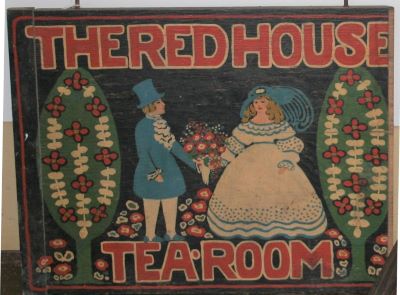 Charlie and Nell Ingersoll resided in this house for more than half of the twentieth century. The Depression and Prohibition came and went, each creating its own impact. World Wars I and II and the Korean War brought their own fears and shortages. The Ingersolls, like the rest of the country, would have experienced gasoline shortages, rationing of eggs and dairy goods, and an unwelcome introduction to margarine. The Ingersolls turned the Arnold Homestead into a cozy nook, where neighbors and friends could gather in the afternoon, listening to Charlie's stories, or laughing with Nell in the backyard or fire-lit living room. Their only child, daughter Elizabeth, was born in 1912 and later married and moved to Westbrook. For a brief period, Nell Ingersoll kept a tea room, "The Red House Tea Room", in the western-most room of the house. Perhaps it was opened in response to the Ingersoll's rising economic needs caused by the stock market crash and Depression, or perhaps Nell hoped to capitalize on the town's growing tourism.
Charlie and Nell Ingersoll resided in this house for more than half of the twentieth century. The Depression and Prohibition came and went, each creating its own impact. World Wars I and II and the Korean War brought their own fears and shortages. The Ingersolls, like the rest of the country, would have experienced gasoline shortages, rationing of eggs and dairy goods, and an unwelcome introduction to margarine. The Ingersolls turned the Arnold Homestead into a cozy nook, where neighbors and friends could gather in the afternoon, listening to Charlie's stories, or laughing with Nell in the backyard or fire-lit living room. Their only child, daughter Elizabeth, was born in 1912 and later married and moved to Westbrook. For a brief period, Nell Ingersoll kept a tea room, "The Red House Tea Room", in the western-most room of the house. Perhaps it was opened in response to the Ingersoll's rising economic needs caused by the stock market crash and Depression, or perhaps Nell hoped to capitalize on the town's growing tourism.
The house was modernized with steam heat and plumbing during the twentieth century. The Ingersolls used the rear "garden door" as their main entrance and made modifications to the interior including a small addition to the southwestern side of the house which contained a small modern kitchen. Charlie Ingersoll died in 1961 and a year later both his sister Harriet and wife Nell passed away.
Hurrah for Old Haddam
After the death of Harriet Ingersoll Jones in 1962, the house was put on the open market and it appeared that the property would leave the Arnold family for the first time since the 1790s. Haddam, however, was in the midst of a revival of historic awareness and appreciation for its past. In 1962 the town celebrated its tercentenary and the Haddam Historical Society prepared a commemorative exhibit to mark the celebration. As part of their fundraising efforts the Society sought out descendants of Haddam's early settlers. Many ancestors of "Haddamites" responded generously including Isaac Arnold of Houston, Texas, a great-great grandson of Thankful and Joseph Arnold. Mr. Arnold purchased the house in March of 1963 and provided funding for its renovation under the direction of Frances Phipps. Ms. Phipps was the president of the Haddam Historical Society and became the chairwoman of the Executive Advisory Committee of the Thankful Arnold House.
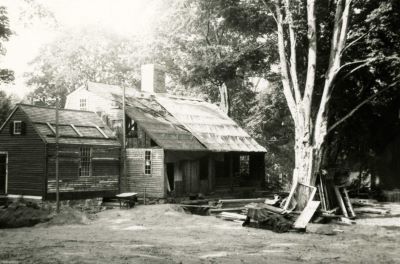 The Executive Committee chose to restore the house to its early nineteenth century appearance and hired Paul Weld, who was well known for other early house restoration projects. The foundation was stabilized, termite infestation was eradicated, and a vault was added to safely store the family papers and other archival materials discovered in the house. The 1920s kitchen ell and the 1869 attic addition were taken down and the salt-box shape of the house was restored. Damaged floorboards were replaced, and more than 150 years of wallpaper and paint were removed. Featheredged paneling and a corner cupboard taken from other Connecticut houses were installed and paint colors popular during the early 1800s were applied to the interior woodwork. Weld's work uncovered the phases of construction which resulted in the current house plan, and his evaluation of the architectural details and clues which he uncovered are the basis for dating the building additions.
The Executive Committee chose to restore the house to its early nineteenth century appearance and hired Paul Weld, who was well known for other early house restoration projects. The foundation was stabilized, termite infestation was eradicated, and a vault was added to safely store the family papers and other archival materials discovered in the house. The 1920s kitchen ell and the 1869 attic addition were taken down and the salt-box shape of the house was restored. Damaged floorboards were replaced, and more than 150 years of wallpaper and paint were removed. Featheredged paneling and a corner cupboard taken from other Connecticut houses were installed and paint colors popular during the early 1800s were applied to the interior woodwork. Weld's work uncovered the phases of construction which resulted in the current house plan, and his evaluation of the architectural details and clues which he uncovered are the basis for dating the building additions.
From the time of his purchase Isaac Arnold of Texas always intended that the house should become the home of the Haddam Historical Society. It was opened to the public on May 29, 1965 and dedicated to "the memory of all descendants of Joseph Arnold, an original proprietor of Haddam in 1662." Upon Mr. Arnold's death in 1973, the title was transferred to the organization, where the story of Joseph and his sons, and Thankful and her daughters and granddaughters can be told.
